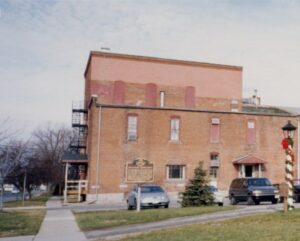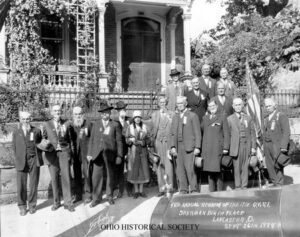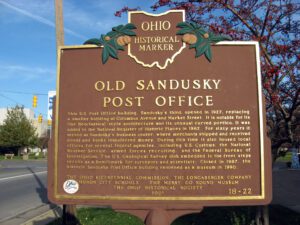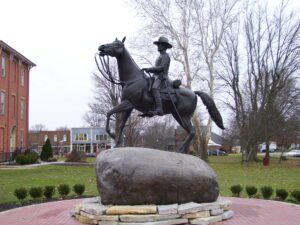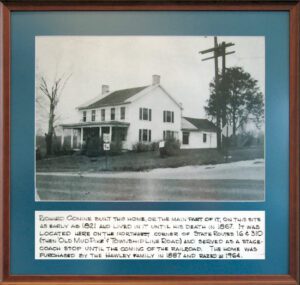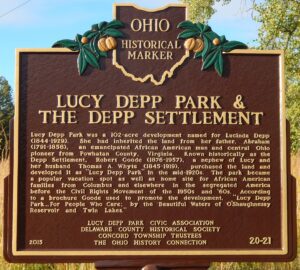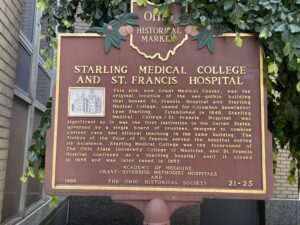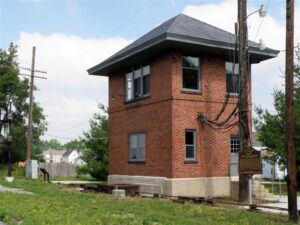, OH
The freight depot east of this marker stands on the western terminus of Hancock County’s first rail link to the outside world. In 1849 the Mad River and Lake Erie Railroad Company opened a branch line from Findlay to its main line at Carey. A freight warehouse was built here ca. 1848 and passenger station in 1863. The Cleveland, Cincinnati, Chicago, and St. Louis Railroad replaced these earlier buildings with the present depot in the 1890s.
, OH
The 17th Infantry, created by Congress in 1812 and formed with personnel from western states, was the only Regular Army regiment in General James Winchester’s column of the Army of the Northwest’s campaign to regain Detroit. During the War of 1812, the 17th fought at Frenchtown, Fort Meigs, Fort Stephenson, and Thames River. In 1815, the 17th was consolidated with the 5th, 19th, and 28th Infantry to form the 3rd Infantry. In May 1861, the 17th Infantry was again organized as a Regular Army regiment and has since served continuously with distinction.
, OH
This U.S. Post Office building, Sandusky’s third, opened in 1927, replacing a smaller building at Columbus Avenue and Market Street. It is notable for its fine Neoclassical-style architecture and its unusual curved portico. It was added to the National Register of Historic Places in 1982. For sixty years it served as Sandusky’s business center, where merchants shipped and received goods and banks transferred money. During this time it also housed local offices for several federal agencies, including U.S. Customs, the National Weather Service, armed forces recruiting, and the Federal Bureau of Investigation. The U.S. Geological Survey disk embedded in the front steps serves as a benchmark for surveyors and scientists. Closed in 1987, the historic Sandusky Post Office building reopened as a museum in 1990.
, OH
W.S. Rosecrans, soldier, engineer, architect and inventor, was born in Kingston Township in 1819. After graduation from West Point in 1842, he served in the Engineering Corps then taught at West Point. As a civilian, he engineered a river lock system and perfected lamp oil. During the Civil War, Rosecrans commanded Union Armies of the Ohio, the Cumberland, and the Missouri, and developed a popular war-time ambulance. “Old Rosy” led his troops to victory at Iuka, Corinth, Stones River and Tullahoma. He helped raise $789,000 for soldiers’ relief and designed St. Joseph’s Cathedral in Columbus. He later served as Minister to Mexico, Registrar to the U.S. Treasury and as a Congressman from California. He died in 1898 and is buried in Arlington National Cemetery. “Stand by your flag and country, my men!”- Rosecrans at the Battle of Stones River, October 4, 1862
, OH
Born in New Jersey, Richard and Sarah Conine, the founders of the village of Pataskala, moved to Lima Township and lived on this site as early as 1821 when Richard established a grist mill nearby. Their homestead also served as a stagecoach stop on the mud pike between Columbus and Newark prior to the coming of the railroad. Richard platted “Conine Town” south and west of here in 1851, and the town was renamed Pataskala soon after. The public-spirited Conines contributed to the building of several area schools and churches and donated land for the Pataskala Cemetery. After their deaths, Sarah’s nephew Jacob Van Dorn inherited the property. John Hawley purchased the home in 1887 and for many years it was known as “The Hawley House.” It was demolished in 1964 to make way for commercial development.
, OH
Lucy Depp Park was a 102-acre development named for Lucinda Depp (1844-1929). She had inherited the land from her father, Abraham (1791-1858), an emancipated African American man and central Ohio pioneer from Powhattan County, Virginia. Known historically as the Depp Settlement, Robert Goode (1876-1957), a nephew of Lucy and her husband Thomas A. Whyte (1845-1919), purchased the land and developed it as “Lucy Depp Park” in the mid-1920s. The park became a popular vacation spot as well as home site for African American families from Columbus and elsewhere in the segregated America before the Civil Rights movement of the 1950s and 60s. According to a brochure Goode used to promote the development, “Lucy Depp Park…For People Who Care; by the Beautiful Waters of O’Shaughnessy Resevoir and Twin Lakes.”
, OH
This site, now Grant Medical Center, was the original location of the neo-gothic building that housed St. Francis Hospital and Starling Medical College, named for Columbus benefactor Lyne Starling. Established in 1849, Starling Medical College/St. Francis Hospital was significant as it was the first institution in the United States, governed by a single board of trustees, designed to combine patient care and clinical teaching in the same building. The Sisters of the Poor of St. Francis served the hospital during its existence. Starling Medical College was the forerunner of The Ohio State University College of Medicine, and St. Francis Hospital continued as a teaching hospital until it closed in 1955 and was later razed in 1957.
, OH
The Bradford or “BF” Tower was built by the Pennsylvania Railroad circa 1929, at the important site of Bradford Junction. It replaced an earlier wooden tower that stood to its west. From this building, operators controlled the movement of every train, aligned track switches, set the track side signals, and relayed messages to the crews in the locomotive and caboose of passing trains. The tower originally housed a desk, telegraph equipment, and the all-important railroad clock. Its core housed many steel throw-arms, known as Armstrong levers. These were hand thrown, connecting track switches and signals via pipes throughout the junction area. The operator telegraphed other outlying towers and dispatching centers in Columbus, Ohio and Indianapolis and Logansport, Indiana. Railroad telephones appeared during the late 1920s and radios just after World War II. The tower was closed January 3, 1984. This is an example of the once common railroad interlocking tower that dotted railroads throughout Ohio and the United States.


